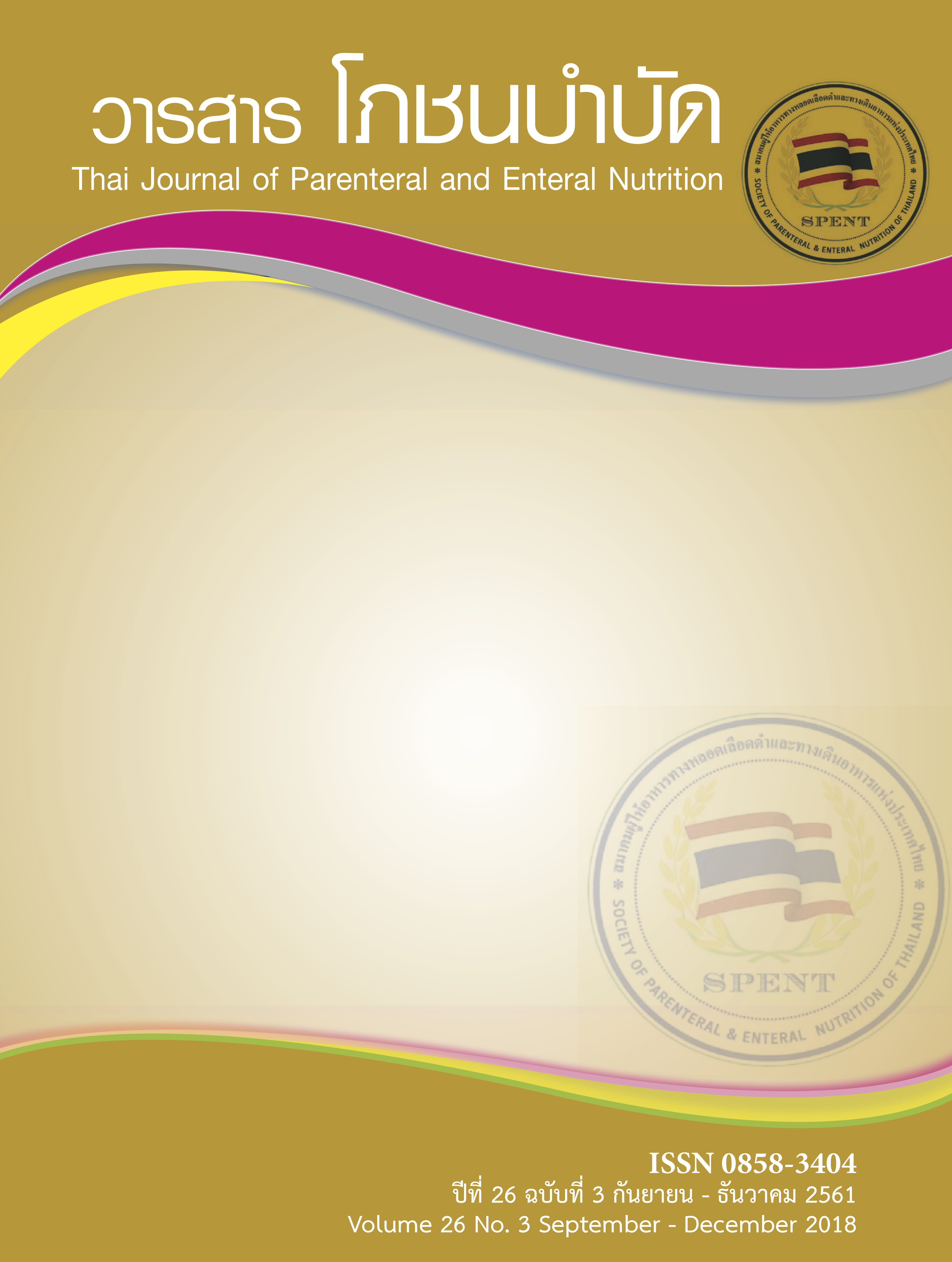สรุปความคิดรวบยอดเรื่องแร่ธาตุที่ร่างกายต้องการในปริมาณน้อย
คำสำคัญ:
trace elements, essential trace elements, deficiency, toxicityบทคัดย่อ
แร่ธาตุที่ร่างกายต้องการต้องการในปริมาณน้อย (Trace Elements, TE) คือแร่ธาตุที่ร่างกายต้องการในระดับไมโครกรัมถึงมิลลิกรัมและมีบทบาทหน้าที่สำคัญในการดำรงอยู่ของสิ่งมีชีวิต ปัจจุบันมี TE อยู่ทั้งหมด 14 ตัว แร่ธาตุต่างๆเหล่านี้ล้วนพบในดิน TE ถูกดูดซึมและสะสมโดยพืชที่เจริญเติบโตในพื้นที่นั้นๆ เราจึงได้รับ TE โดยตรงเมื่อรับประทานพืชเหล่านี้เป็นอาหาร หรือโดยทางอ้อมคือเมื่อพืชเหล่านี้เป็นอาหารตามธรรมชาติของสัตว์ แล้วเรารับประทานเนื้อสัตว์นั้นๆเป็นอาหารอีกต่อหนึ่งปริมาณ TE ในดินจึงเป็นปัจจัยสำคัญที่กำหนดปริมาณ TE ในอาหารของมนุษย์ TE ที่มีความสำคัญในมนุษย์หมายถึง TE ที่ได้รับการยืนยันแล้วว่าเมื่อเกิดภาวะขาด TE นั้นๆ แล้วจะก่อให้เกิดโรคหรือผลเสียต่อสุขภาพ โดยปกติร่างกายจะควบคุมสมดุลปริมาณของ TE โดยการปรับเปลี่ยนอัตราการดูดซึม TE จากทางเดินอาหาร และการขับ TE ทิ้งจากร่างกายผ่านทางไตหรือตับ หากร่างกายมีความผิดปกติของการควบคุมการดูดซึม หรือการขับ TE ออก หรือได้รับ TE ในปริมาณสูงเกินกว่าที่ร่างกายจะปรับตัวได้ทันก็อาจเกิดภาวะเป็นพิษจาก TE ได้
เอกสารอ้างอิง
Mertz W. The essential trace elements. Science 1981;213:1332-8.
Mertz W. The newer essential trace elements, chromium, tin, nickel, vanadium and silicon. Proc Nutr Soc 1974;33:307-13.
Chen J. An original discovery: selenium deficiency and Keshan disease (an endemic heart disease). Asia Pac J Clin Nutr 2012;21:320-6.
Longnecker MP, Taylor PR, Levander OA, et al. Selenium in diet, blood, and toenails in relation to human health in a seleniferous area. Am J Clin Nutr 1991; 53:1288-94.
Ross AC, Caballero B, Cousins RJ, et al. Modern Nutrition in Health and Disease. Eleventh edition. Philadelphia: Lippincott Williams & Wilkins; 2012.
Nagataki S. The average of dietary iodine intake due to the ingestion of seaweeds is 1.2 mg/day in Japan. Thyroid Off J Am Thyroid Assoc 2008;18:667-8.
Bürgi H. Iodine excess. Best Pract Res Clin Endocrinol Metab 2010;24:107-15.
Leung AM, Braverman LE. Consequences of excess iodine. Nat Rev Endocrinol 2014;10:136-42.
van der Reijden OL, Zimmermann MB, Galetti V. Iodine in dairy milk: Sources, concentrations and importance to human health. Best Pract Res Clin
Endocrinol Metab 2017;31:385-95.
Flachowsky G, Franke K, Meyer U, et al. Influencing factors on iodine content of cow milk. Eur J Nutr 2014;53:351-65.
Knowles JM, Garrett GS, Gorstein J, et al. Household Coverage with Adequately Iodized Salt Varies Greatly between Countries and by Residence Type and Socioeconomic Status within Countries: Results from
National Coverage Surveys. J Nutr 2017;147:1004S.
Anderson RA, Bryden NA, Polansky MM. Dietary chromium intake. Freely chosen diets, institutional diet, and individual foods. Biol Trace Elem Res 1992;32: 117-21.
Khera D, Sharma B, Singh K. Copper deficiency as a cause of neutropenia in a case of coeliac disease. BMJ Case Rep; 2016. DOI: 10.1136/bcr-2016-214874.
Prasad AS. Discovery of human zinc deficiency: its impact on human health and disease. Adv Nutr Bethesda Md 2013;4:176-90.
Kwon Y, Kim HJ, Lo Menzo E, et al. Anemia, iron and vitamin B12 deficiencies after sleeve gastrectomy compared to Roux-en-Y gastric bypass: a metaanalysis.
Surg Obes Relat Dis Off J Am Soc Bariatr Surg 2014;10:589-97.
Vermeulen H, Westerbos SJ, Ubbink DT. Benefit and harm of iodine in wound care: a systematic review. J Hosp Infect 2010;76:191-9.
Schmidt M, Goebeler M. Nickel allergies: paying the Toll for innate immunity. J Mol Med Berl Ger 2011; 89:961-70.
EFSA Panel on Dietetic Products N and A (NDA). Scientific opinion on dietary reference values for chro-mium. EFSA J; 12. DOI: 10.2903/j.efsa.2014.3845.
Friedman BJ, Freeland-Graves JH, Bales CW, et al. Manganese balance and clinical observations in young men fed a manganese-deficient diet. J Nutr 1987;117:133-43.
Dastych M, Dastych M, Senkyrík M. Manganese in whole blood and hair in patients with long-term home parenteral nutrition. Clin Lab 2016;62:173-7.
Reimund JM, Dietemann JL, Warter JM, et al. Factors associated to hypermanganesemia in patients receiving home parenteral nutrition. Clin Nutr 2000;
:343-8.
Bhowmick S, Pramanik S, Singh P, et al. Arsenic in groundwater of West Bengal, India: A review of human health risks and assessment of possible intervention
options. Sci Total Environ 2018;612:148-69.
Viswanathan G, Jaswanth A, Gopalakrishnan S, et al. Determining the optimal fluoride concentration in drinking water for fluoride endemic regions in South
India. Sci Total Environ 2009;407:5298-307.
Levison DA, Crocker PR, Banim S, et al. Silica stones in the urinary bladder. Lancet 1982;1:704-5.
Lee MH, Lee YH, Hsu TH, et al. Silica stone-development due to long time oral trisilicate intake. Scand J Urol Nephrol 1993;27:267-9.
Farrer JH, Rajfer J. Silicate urolithiasis. J Urol 1984; 132:739-40.
Morris JS, Crane SB. Selenium toxicity from a misformulated dietary supplement, adverse health effects, and the temporal response in the nail biologic
monitor. Nutrients 2013;5:1024-57.
MacFarquhar JK, Broussard DL, Melstrom P, et al. Acute selenium toxicity associated with a dietary supplement. Arch Intern Med 2010;170:256-61.
Evans RM, Davies PJ, Costa M. Video time-lapse microscopy of phagocytosis and intracellular fate of crystalline nickel sulfide particles in cultured mammalian
cells. Cancer Res 1982;42:2729-35.
Zhao J, Shi X, Castranova V, et al. Occupational toxicology toxicology of nickel and nickel compounds. J Environ Pathol Toxicol Oncol; 28. DOI: 10.1615/JEnvironPathol ToxicolOncol.v28.i3.10.
Schaumlöffel D. Nickel species: analysis and toxic effects. J Trace Elem Med Biol Organ Soc Miner Trace Elem GMS 2012;26:1-6.
Korczynski RE. Occupational health concerns in the welding industry. Appl Occup Environ Hyg 2000;15: 936-45.
Jiang Y-M, Mo X-A, Du F-Q, et al. Effective treatment of manganese-induced occupational Parkinsonism with p-aminosalicylic acid: a case of 17-year follow-up study. J Occup Environ Med 2006;48:644-9.
Fortoul TI, Rojas-Lemus M, Rodriguez-Lara V, et al. Overview of environmental and occupational vanadium exposure and associated health outcomes: An
article based on a presentation at the 8th International Symposium on Vanadium Chemistry, Biological Chemistry, and Toxicology, Washington DC, August
-18, 2012. J Immunotoxicol 2014;11:13-8.
Sayli BS. Assessment of fertility and infertility in boron- exposed Turkish subpopulations: 3. Evaluation of fertility among sibs and in ùborate familiesû. Biol Trace Elem Res 2001;81:255-67.
Robbins WA, Wei F, Elashoff DA, et al. Y:X sperm ratio in boron-exposed men. J Androl 2008;29:115-21.
Restuccio A, Mortensen ME, Kelley MT. Fatal ingestion of boric acid in an adult. Am J Emerg Med 1992;10:545-7.
Boulassel B, Sadeg N, Roussel O, et al. Fatal poisoning by vanadium. Forensic Sci Int 2011;206:e79-81.
Aschner JL, Aschner M. Nutritional aspects of manganese homeostasis. Mol Aspects Med 2005;26:353-62.
Pennington JA. A review of iodine toxicity reports. J Am Diet Assoc 1990;90:1571-81.
Fuqua BK, Vulpe CD, Anderson GJ. Intestinal iron absorption. J Trace Elem Med Biol Organ Soc Miner Trace Elem GMS 2012;26:115-9.
ดาวน์โหลด
เผยแพร่แล้ว
รูปแบบการอ้างอิง
ฉบับ
ประเภทบทความ
สัญญาอนุญาต
เนื้อหาและข้อมูลในบทความที่ตีพิมพ์ลงใน Thai JPEN วารสารโภชนบำบัด ถือเป็นข้อคิดเห็นและความรับผิดชอบของผู้เขียนบทความโดยตรงซึ่งกองบรรณาธิการวารสารไม่จำเป็นต้องเห็นด้วยหรือร่วมรับผิดชอบใด ๆ
บทความ ข้อมูล เนื้อหา รูปภาพ ฯลฯ ที่ได้รับการตีพิมพ์ใน Thai JPEN วารสารโภชนบำบัด ถือเป็นลิขสิทธิ์ของ Thai JPEN วารสารโภชนบำบัด หากบุคคลหรืหน่วยงานใดต้องการนำทั้งหมดหรือส่วนใดส่วนหนึ่งไปเผยแพร่หรือเพื่อกระทำการใด จะต้องได้รับอนุญาตเป็นลายลักษณ์อักษรจาก Thai JPEN วารสารโภชนบำบัด ก่อนเท่านั้น



